Definition
Classical conditioning or Pavlovian conditioning is part of behaviorism theory that describes learned involuntary responses through association; this in the presence of a neutral stimulus that will eventually provide the same response as an unconditioned or involuntary one on its own. The most famous example of classical conditioning is Pavlov’s dogs. While the natural or conditioned response is the result of sensory information, an unconditioned but similar response can be created by introducing a separate stimulus at the same time.
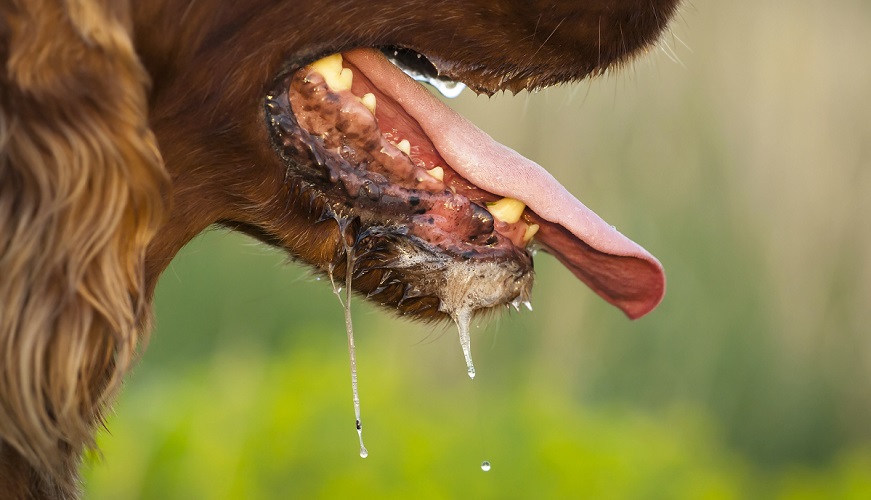
Classical Conditioning Theory
Classical conditioning theory began with Ivan Pavlov in the early 20th century, when he looked into the response of the digestive system in the presence (sight and odor) of food. Pavlov’s research animals – dogs – would automatically salivate whenever food was offered. By sounding a whistle every time the dogs were fed, they were eventually conditioned by a usually ineffective stimulus to salivate without any food being present. The whistle alone caused a physiological effect that was previously an automatic response to the stimulus of food.
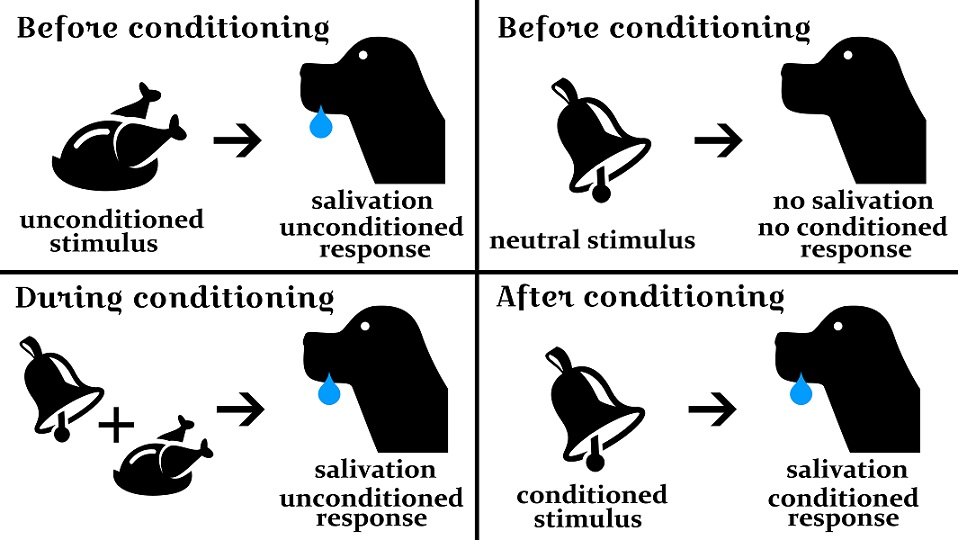
Classical conditioning theory is composed of three phases – before, during, and after.
Before Conditioning
Before an animal or a human is conditioned to respond to a usually ineffective (neutral) stimulus, physiological or psychological responses only occur in the presence of certain, naturally occurring stimuli. These are known as unconditioned stimuli or UCS. When we think of conditional circumstances, we think of some kind of control or restriction. You can go to the party on the condition that you tidy your room first, for example. When we think of unconditioned circumstances – unconditional love, for example – there are no restrictions. So an unconditioned response is not controlled, it is an involuntary act. More specifically, no learning is required. The definition of classical conditioning is to do with external control – you react on the condition that you have learned to associate an unusual sensory stimulus with a natural one.
An example of an unconditioned response is a newborn baby using the muscles of its mouth to carry out a sucking motion. It is a reflex that occurs when an unconditioned stimulus or UCS is placed in the newborn’s mouth – a nipple or the teat of a bottle offers nutrient-rich milk. It is not the mode of delivery that is the unconditioned stimulus during the very first feeds, but the milk. The unconditioned response to this stimulus is the sucking reflex. It is easy to see how unconditioned responses are often survival mechanisms. If the newborn does not know how to suck, it cannot eat and it will die.

Eventually, the infant will learn to associate the form of the nipple or teat in its mouth with the sucking reflex. It has then become a conditioned response, because the baby has learned that these provide a source of milk. A further step will be the baby associating the sight of a bottle or breast – any breast, even at a distance or on television – with food. A conditioned stimulus is a stimulus associated with the natural unconditioned stimulus. If a bell would be rung every time a newborn baby had a feed, that baby would eventually begin to suck at the air if only a bell rings – the same type of learned behavior as the conditioned salivation response of Pavlov’s dogs.
A conditioned response (CR) is always in reaction to a conditioned stimulus (CS). Even though the type of response is the same – salivation or reflex sucking for example – one is a natural phenomenon and the other a learned behavior.
Examples of unconditioned responses are the effects of odors on the senses that are not the product of memories; the smell of rotten meat is unpleasant to everyone because survival mechanisms in the body want to stop us from eating it and becoming ill. A sudden, loud noise automatically produces feelings of tension. Warmth relaxes. These are natural, involuntary, and unlearned responses to our environment.

During Conditioning
The second phase of classical conditioning is the during phase. This is when a neutral stimulus (noise, touch, smell, taste) is added every time there is an unconditioned stimulus. This is the conditioned stimulus (CS) – the subject must learn to respond to it as the stimulus will not cause the unconditioned response on its own. Pavlov introduced a bell between one to two seconds before he fed his dogs. It is very important that the conditioned stimulus is given very shortly before or during the unconditioned stimulus. The dogs needed time to learn to associate the bell with food – this is the during conditioning phase.

However, the during conditioning phase of classical conditioning does not have to take a long time. Sometimes, an unconditioned stimulus is so strong it will immediately be associated with a conditioned one. Many of our learned fear responses are based upon short-term during conditioning phases. Another term for the during conditioning phase is the acquisition phase, where a conditioned stimulus is introduced and the association between it and the unconditioned stimulus is strengthened.
After Conditioning
After conditioning is self-explanatory. Classical conditioning has occurred and there is now a conditioned response to a conditioned stimulus. The conditioned response is the same type of response as the unconditioned response, but the conditioned and unconditioned stimuli are not the same. The subject has developed a new learned response to a stimulus that in normal circumstances would not cause this effect. The unconditioned stimulus no longer needs needs the unconditioned stimulus to create an effect that mimics the natural, involuntary response. Natural responses are the result of the parasympathetic and sympathetic nervous system and with classical conditioning, stimuli that would not activate either system in normal circumstances can eventually produce them.
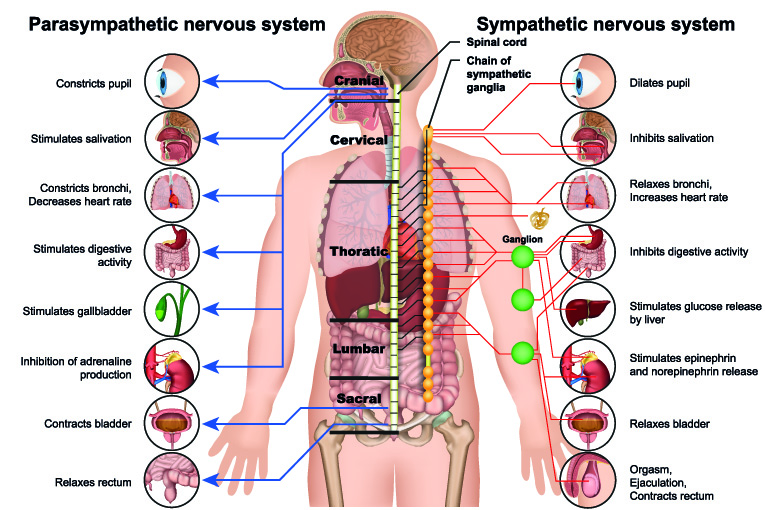
So if you are asked the question, “What is classical conditioning”, you should now be able to answer it. A very short answer would be the association of an neutral stimulus with the natural cause of an involuntary physiological response, and that this association becomes so strong the neutral stimulus is all that is needed to create the effect.
How long this lasts depends on how long the brain associates the CS with the UCS. When the bell is no longer rung one to two seconds before food, Pavlov’s dogs will eventually stop salivating in response to that sound. This is called classical conditioning extinction, where extinction refers to the conditioned response.
However, memory is complex and spontaneous recovery of a conditioned response is possible after classical conditioning extinction occurs. This is usually very short-term. In the absence of the pairing of an unconditional and conditional response, the subject will ‘learn’ that there is no need for a response. The association between conditioned and unconditioned stimulus is rarely completely lost. If, after a long period of time, the during conditioning phase is repeated, it will take much less time to develop the same conditioned response.
Sometimes the conditional stimuli will become generalized. If someone said “Oliver Twist” one to two seconds before they burn your left hand with a match at every opportunity you will become conditioned to pull your left hand away when you hear those words. But other memory pathways may cause you to include more generalized conditional stimuli. You may suddenly jerk your left hand if someone says “Dickens”, for example. This is called stimulus generalization.
The opposite effect is stimulus discrimination. Only extremely specific stimuli will cause the conditional response. Perhaps “Oliver Twist” must be said a certain way or at a certain tempo or rhythm for you to pull your left hand out of danger. Or perhaps only small spiders with hairy legs will cause a fear response, while those with long, thin legs have no effect on anxiety levels at all.

Classical vs Operant Conditioning
Classical conditioning and operant conditioning are two different learning processes. As we have already seen, the conditioned relationship involves pairing a neutral stimulus with an unconditioned stimulus to eventually produce a learned physiological response only to the previously neutral stimulus. A classical conditioning response is an involuntary one. How well this process works depends on certain variables – how frequently the conditioned and unconditioned stimuli are paired, the length of time of the during conditioning phase, and the time span between conditioned and unconditioned stimulus. If Pavlov had rung that bell an hour before or after the dogs were fed, the bell would never have made them drool.
Operant conditioning or instrumental conditioning is also part of associative learning but involves voluntary behaviors and the consequences of these behaviors. An operant response is a voluntary one. Getting your dog to roll over whenever you point at him or her is an example of operant conditioning. Only when you praise the dog or reward it for rolling on the ground on command will it learn to do it. Your dog needs to choose to roll over. On the flip side, if the same dog starts to relieve itself on the carpet, a stern voice is a punishment that can decrease that behavior. The dog must choose not to. The circus elephants below have chosen to perform. Whether this choice is made through the anticipation of reward or punishment depends on the trainer.
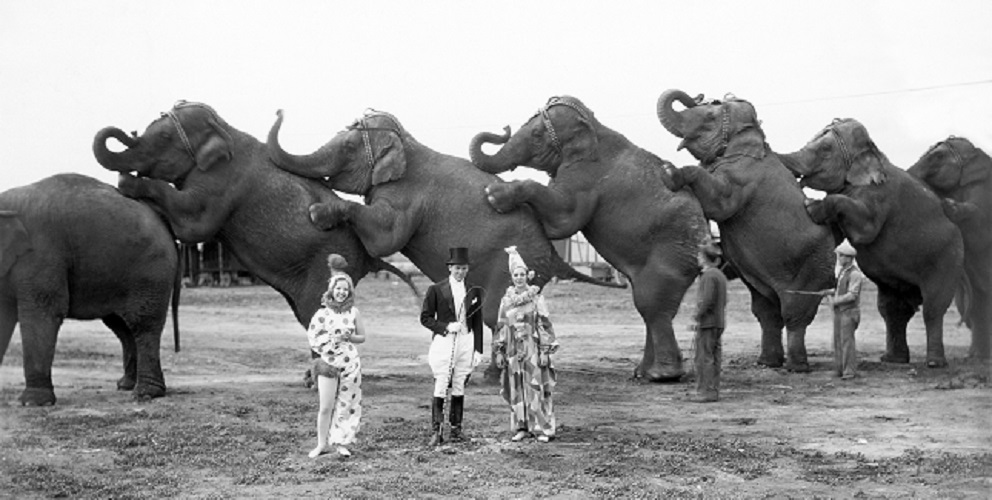
If every time the dog peed on the carpet you rang a bell, eventually you would only need to ring a bell to cause a conditioned response – if there is urine in the dog’s bladder. So when it comes to the difference between classical and operant conditioning, they are two very different things. One is an involuntary reaction (classical) and the other a considered choice (operant).
Classical Conditioning Examples
Classical conditioning examples nearly always include Pavlov’s dog experiment as it was the first to introduce this associative learning theory. Research spanning different species from sea slugs to humans has shown how organisms can learn to respond in a way that is extremely similar to a natural, involuntary reaction, but to a neutral stimulus. In psychology, classical conditioning has been used as a method to help treat fear, anxiety, and addiction. Various examples of classical conditioning in psychology are included in this section.
You will be able to think of at least two or three classical conditioning examples in everyday life just by going through your day. When you turn on the TV you feel like eating, when you get near to a point in a video game that you know is tough your heart begins to race, when your dog hears the rattle of its lead it gets excited. These are all learned associations that affect the nervous system. The first time you played that video game you might not have known it would be so tough and frustrating, when the dog first arrived at your home as a puppy it had no idea what a lead was, and when you first watched the TV as a very young child chances were you weren’t looking for something to snack on.
An increased heart rate is an unconditioned response to the unconditioned stimuli of excitatory neurotransmitters. It is a survival mechanism, pumping oxygen to the vital organs and muscles in preparation for action. Many phobias are instinctive. For example, some birds, even when raised in laboratory environments without contact with wild birds of the same species, will still race to form a dense cloud if exposed to the real or artificial shadow of a predatory hawk.

Yet the majority of fears are conditioned. Over time, we learn to dread examinations or air travel. Various conditioned stimuli – a bad result, the reactions of others, watching a disaster movie – can strengthen the conditioned fear response. Simply thinking about a future test or trip or even looking at a picture of a plane can cause the heart to race. Conditioned fear responses include autonomic changes such as an increased heart rate, defensive behaviors such as standing like a deer in headlights or running away, hormone release, a lower sensitivity to pain and the activation of certain reflexes – the blink reflex, for example. These conditioned responses strongly mimic their associated unconditioned responses.
Research on sea slugs, a basic life-form, gives another example of classical conditioning. Sea slugs collect oxygen from water using a set of gills that are covered by a fleshy flap. De-oxygenated water is released via a small tube called a siphon. If the siphon is touched, the gills tuck themselves further under the flap. This is an unconditional response guided by sensory neurotransmitters. Some unfortunate sea slugs in a laboratory were able to show that even the simplest organisms learn through association.
First, they were touched repeatedly on the siphon – ten to fifteen times each time. It was found that, after the initial touches, the sea slugs’ unconditioned response diminished. They became used to the touch and did not continue to respond with the same force. This is called habituation. The next step was to first touch the sea slugs very gently on the siphon, and then hit them hard on the head or tail.
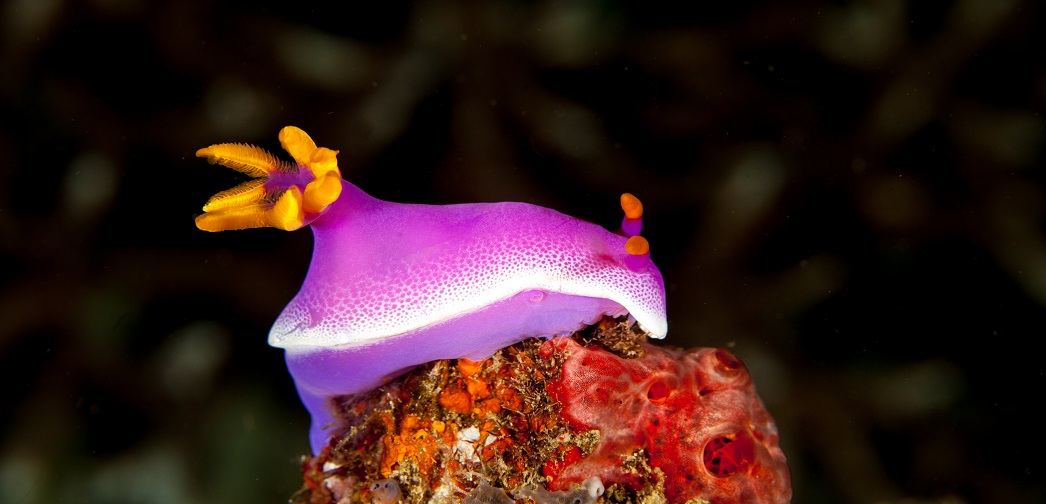
The result? A much greater response to a potentially greater threat. Even a gentle touch on the siphon would cause the gills to retreat rapidly under the flap, much deeper than usual. After time, the sea slugs learned that a gentle touch would be followed by a much more serious attack. They learned to pull the gills as deep as possible in the presence of a light touch and no other stimuli. In this case, the gentle touch was the conditioned stimulus and the blow to the head or tail the unconditioned stimulus.
The use of placebos in medicine is a very gray area. However, in the right circumstances they can alleviate suffering. This is unfortunately a classical conditioning example in everyday life for many long-term illnesses. One example of placebo-related Pavlovian conditioning reports how cancer patients undergoing chemotherapy and with high levels of pain would be give intravenous morphine. Over time, the association of a needle with the unconditioned effects of the drug was made. It was then found that any injection – with anti-nausea medication or even sterile water – would help to relieve pain in this group of patients. The conditioned stimulus of the needle caused a conditioned response very similar to the unconditioned response it had been associated with – pain relief.

Speaking of nausea, this is commonly a natural, involuntary, and, therefore, unconditioned response to unconditioned stimuli such as contaminated food and medications. Yet when we begin to anticipate nausea, a whole range of triggers can become conditioned stimuli and make us feel unwell as a conditioned response. Many chemotherapy patients feel nauseous before the drugs are administered, perhaps due to the smell of the ward, the color of the treatment area walls, even certain landmarks on the route to the hospital. These stimuli have become associated with the feeling of nausea caused by the drugs. After a time, these stimuli are enough to cause nausea on their own. They also show that in higher organisms the time between conditioned stimulus and unconditioned stimulus can be longer.
In psychology, counter conditioning is used to treat phobias. This is a great way to get over arachnophobia – a fear-conditioned disorder that affects up to six percent of the global population. Counter conditioning is based on Pavlov’s classical conditioning psychology and aims to achieve a relaxed response when a spider is present. The person with the phobia must first learn how to relax without the stimulus (spider) using meditation and deep breathing techniques. The next step is for the person to make a chart of fear scores – a fear hierarchy. For example, thinking about a spider might rate ten on a scale of one hundred and touching a real spider could rate the top score. Gradually, the person works their way up the list. By associating the conditioned response of relaxation with thinking of a spider, the anxiety levels fall. Once the person no longer experiences fear when thinking about a spider it is time to tackle the next step on their fear hierarchy chart – perhaps looking at a spider web, or at a spider behind glass, or a picture of a spider.

The final classical conditioning example in this article deals with addiction. Addiction covers all types of products and behaviors, from obsessive-compulsive disorder where a person must, for example, constantly wash their hands to feel safe to food addiction, where an association is made between food and comfort, and to substance abuse. The thread that runs through all addiction involves cue-induced cravings. Someone with an eating disorder may immediately want to eat when they sit on the sofa as they have learned to associate sitting on the sofa with eating. A former drug addict who has overcome an addiction is advised to change their environment as during their addiction they learned to associate certain friends or surroundings with drug use. Smokers might associate coffee with a cigarette. One treatment used for children with sugar addiction is to play board games together in front of a bowl of sweets that they are not allowed to eat. Instead of associating the sweets with immediate gratification and perhaps a sense of comfort, they learn to associate fun and games with the same feeling instead. If this is repeated, the urge to eat sweets is reduced. Other behavioral theories are also at play, such as operant conditioning (the child chooses to ignore the sweets because they want the reward of the board game) but the physiological effects of being in the presence can be adjusted by classical means. Knowing what classical conditioning is and how it works is important for people suffering from various forms of addiction to understand.
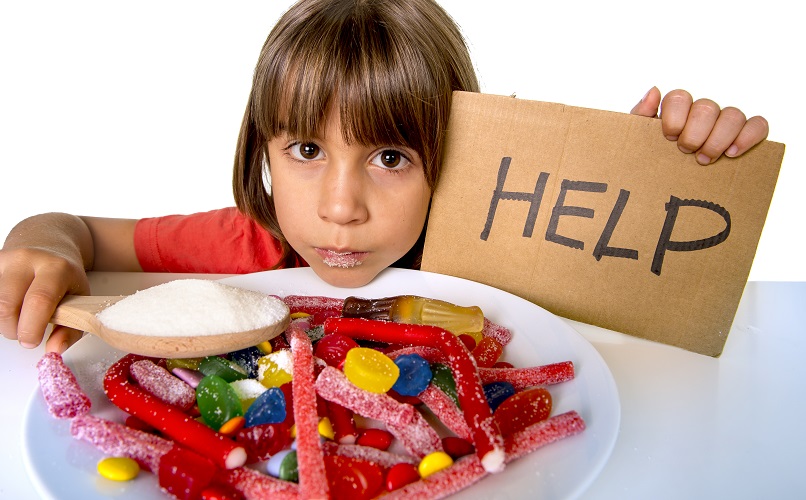
Quiz
